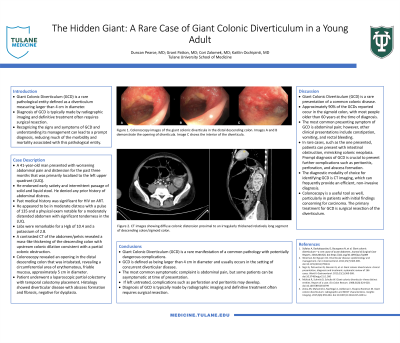Monday Poster Session
Category: Colon
P2002 - The Hidden Giant: A Rare Case of Giant Colonic Diverticulum in a Young Adult
Monday, October 28, 2024
10:30 AM - 4:00 PM ET
Location: Exhibit Hall E

Has Audio
- DP
Duncan Pearce, MD
Tulane Medical Center
New Orleans, LA
Presenting Author(s)
Duncan Pearce, MD, Grant Patton, MD, Corinne Zalomek, MD, Kaitlin Occhipinti, MD
Tulane Medical Center, New Orleans, LA
Introduction: Giant Colonic Diverticulum (GCD) is a rare pathological entity defined as a diverticulum measuring larger than 4 cm in diameter. Understanding the presentation and underlying pathology of GCD can aid in the prompt diagnosis and treatment of this rare variant.
Case Description/Methods: A 41-year-old man presented with worsening abdominal pain and distention for the past three months that was primarily localized to the left upper quadrant (LUQ). He endorsed early satiety and intermittent passage of solid and liquid stool. He denied any prior history of abdominal distress. Past medical history was significant for HIV on ART. He appeared to be in moderate distress with a pulse of 135 and a physical exam notable for a moderately distended abdomen with significant tenderness in the LUQ. Labs were remarkable for a Hgb of 10.4 and a potassium of 2.8. A contrasted CT of the abdomen/pelvis revealed a mass-like thickening of the descending colon with upstream colonic dilation consistent with a partial colonic obstruction. Colonoscopy revealed an opening in the distal descending colon that was intubated, revealing a circumferential area of erythematous mucosa, approximately 5 cm in diameter. Patient underwent a laparoscopic left partial colectomy with temporal colostomy placement. Histology showed diverticular disease with abscess formation and fibrosis, negative for dysplasia.
Discussion: Giant Colonic Diverticulum (GCD) is a rare presentation of a common colonic disease. Approximately 90% of the GCDs reported occur in the sigmoid colon, with most people older than 60 years at the time of diagnosis. The most common presenting symptom of GCD is abdominal pain; however, other clinical presentations include constipation, vomiting, and rectal bleeding. In rare cases, such as the one presented, patients can present with intestinal obstruction, mimicking colonic neoplasia. Prompt diagnosis of GCD is crucial to prevent further complications such as peritonitis, perforation, and abscess formation.
The diagnostic modality of choice for identifying GCD is CT imaging, which can frequently provide an efficient, non-invasive diagnosis. Colonoscopy is a useful tool as well, particularly in patients with initial findings concerning for carcinoma. The primary treatment for GCD is surgical resection of the diverticulum. Recognizing the signs and symptoms of GCD and understanding its management can lead to a prompt diagnosis, reducing much of the morbidity and mortality associated with this pathological entity.

Disclosures:
Duncan Pearce, MD, Grant Patton, MD, Corinne Zalomek, MD, Kaitlin Occhipinti, MD. P2002 - The Hidden Giant: A Rare Case of Giant Colonic Diverticulum in a Young Adult, ACG 2024 Annual Scientific Meeting Abstracts. Philadelphia, PA: American College of Gastroenterology.
Tulane Medical Center, New Orleans, LA
Introduction: Giant Colonic Diverticulum (GCD) is a rare pathological entity defined as a diverticulum measuring larger than 4 cm in diameter. Understanding the presentation and underlying pathology of GCD can aid in the prompt diagnosis and treatment of this rare variant.
Case Description/Methods: A 41-year-old man presented with worsening abdominal pain and distention for the past three months that was primarily localized to the left upper quadrant (LUQ). He endorsed early satiety and intermittent passage of solid and liquid stool. He denied any prior history of abdominal distress. Past medical history was significant for HIV on ART. He appeared to be in moderate distress with a pulse of 135 and a physical exam notable for a moderately distended abdomen with significant tenderness in the LUQ. Labs were remarkable for a Hgb of 10.4 and a potassium of 2.8. A contrasted CT of the abdomen/pelvis revealed a mass-like thickening of the descending colon with upstream colonic dilation consistent with a partial colonic obstruction. Colonoscopy revealed an opening in the distal descending colon that was intubated, revealing a circumferential area of erythematous mucosa, approximately 5 cm in diameter. Patient underwent a laparoscopic left partial colectomy with temporal colostomy placement. Histology showed diverticular disease with abscess formation and fibrosis, negative for dysplasia.
Discussion: Giant Colonic Diverticulum (GCD) is a rare presentation of a common colonic disease. Approximately 90% of the GCDs reported occur in the sigmoid colon, with most people older than 60 years at the time of diagnosis. The most common presenting symptom of GCD is abdominal pain; however, other clinical presentations include constipation, vomiting, and rectal bleeding. In rare cases, such as the one presented, patients can present with intestinal obstruction, mimicking colonic neoplasia. Prompt diagnosis of GCD is crucial to prevent further complications such as peritonitis, perforation, and abscess formation.
The diagnostic modality of choice for identifying GCD is CT imaging, which can frequently provide an efficient, non-invasive diagnosis. Colonoscopy is a useful tool as well, particularly in patients with initial findings concerning for carcinoma. The primary treatment for GCD is surgical resection of the diverticulum. Recognizing the signs and symptoms of GCD and understanding its management can lead to a prompt diagnosis, reducing much of the morbidity and mortality associated with this pathological entity.

Figure: Colonoscopy images of the giant colonic diverticula in the distal descending colon. Images A and B demonstrate the opening of diverticula. Image C shows the interior of the diverticula.
Disclosures:
Duncan Pearce indicated no relevant financial relationships.
Grant Patton indicated no relevant financial relationships.
Corinne Zalomek indicated no relevant financial relationships.
Kaitlin Occhipinti indicated no relevant financial relationships.
Duncan Pearce, MD, Grant Patton, MD, Corinne Zalomek, MD, Kaitlin Occhipinti, MD. P2002 - The Hidden Giant: A Rare Case of Giant Colonic Diverticulum in a Young Adult, ACG 2024 Annual Scientific Meeting Abstracts. Philadelphia, PA: American College of Gastroenterology.
